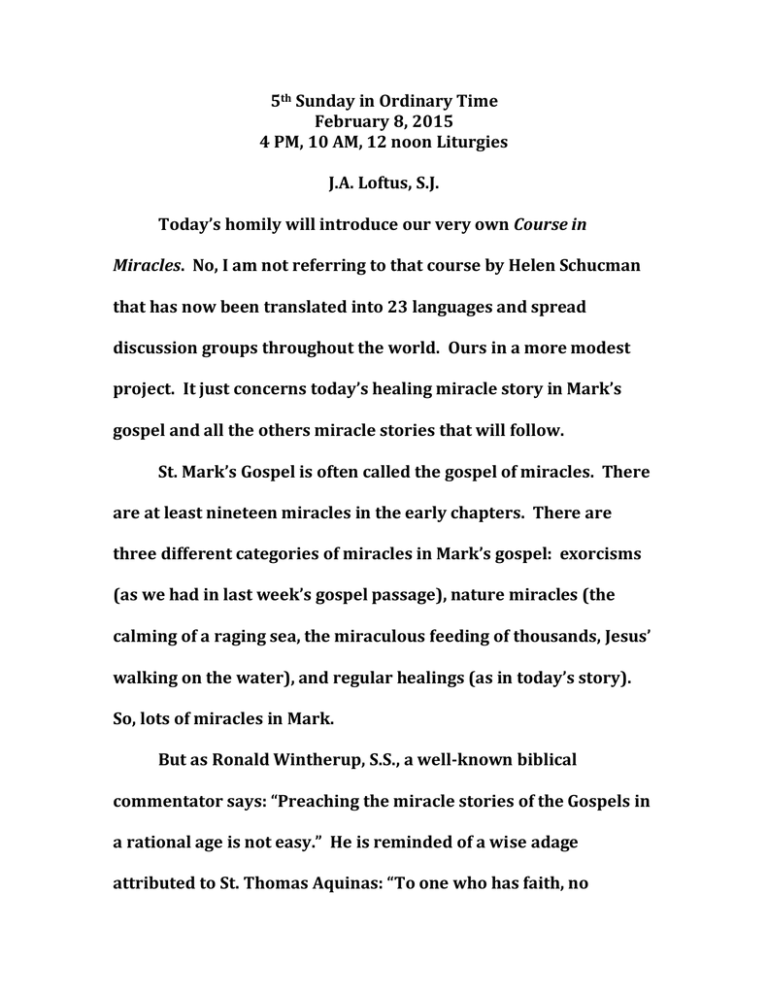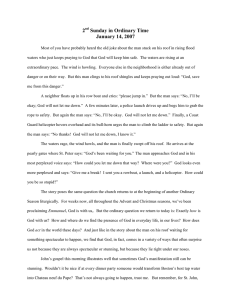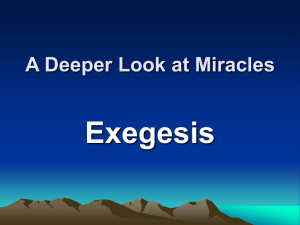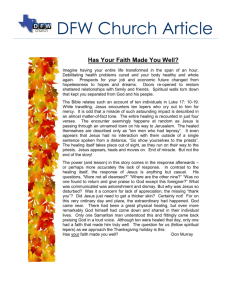5 Sunday in Ordinary Time February 8, 2015
advertisement

5th Sunday in Ordinary Time February 8, 2015 4 PM, 10 AM, 12 noon Liturgies J.A. Loftus, S.J. Today’s homily will introduce our very own Course in Miracles. No, I am not referring to that course by Helen Schucman that has now been translated into 23 languages and spread discussion groups throughout the world. Ours in a more modest project. It just concerns today’s healing miracle story in Mark’s gospel and all the others miracle stories that will follow. St. Mark’s Gospel is often called the gospel of miracles. There are at least nineteen miracles in the early chapters. There are three different categories of miracles in Mark’s gospel: exorcisms (as we had in last week’s gospel passage), nature miracles (the calming of a raging sea, the miraculous feeding of thousands, Jesus’ walking on the water), and regular healings (as in today’s story). So, lots of miracles in Mark. But as Ronald Wintherup, S.S., a well-known biblical commentator says: “Preaching the miracle stories of the Gospels in a rational age is not easy.” He is reminded of a wise adage attributed to St. Thomas Aquinas: “To one who has faith, no explanation is necessary. To one who has no faith, no explanation is sufficient.” Miracles and faith go hand in hand. Again following Wintherup’s commentary, in common parlance, a miracle is just an unexplainable phenomenon outside the normal range of human experience. It is supernatural or transcendent. But in Mark’s gospel (as in Matthew and Luke’s versions), miracles are called “deeds of power” (the Greek word used is dynamis). They are always intimately related to Jesus’ authority, power, and teaching. All the stories of Jesus’ “deeds of power” are finally and intimately connected to the greatest miracle of all, the one that takes place in Jesus’ self-sacrifice on the cross. In Mark’s perspective, Jesus explicitly rejects the notion that he is just another “miracle worker,” just another folk healer. (There were many of those around Palestine in his time.) And Jesus silences the demons who think they know he is the “Holy One of God” (as in last Sunday’s gospel). They do not know him; they are looking for a super-healer and super-miracle worker. That’s not Jesus either. He doesn’t either need or want “fans.” 2 The miracles are not about gathering a fan club, which is exactly what happens in today’s gospel snippet. “Everybody is looking for you,” Peter tells him. And “the whole town” was seeking him. But Mark is steadfast; they are seeking only a fake and faint Messiah. The real one will only be revealed at the end of story. In the end, a Roman Centurion at the cross reveals Mark’s great “Messianic Secret”. At Jesus’ death the Centurion is the one who says: “Truly this was the Son of God.” Miracles and faith always go together. “Miracles are stories of God’s power and ability to enter our world in ways beyond our comprehension…. They are God’s powerful teaching at work in Jesus Christ” (Winterup). So we cannot avoid teaching about these miracles. But we can avoid trying to find purely rationalistic explanations or purely fantastical explanations for them. They are about God’s power in God’s universe. For Jesus most of the healing miracles (like in today’s story) are about more than curing diseases. They are about a broader notion of healing illness. They are about restoring people to their 3 communities and families, or allowing them to be restored to their larger purpose in life. In he case of Simon’s mother-in-law there appears to be both a cure and a more profound healing and restoration to the family and community. The cure comes from his simple touch. The healing comes when she immediately returns to her familial service to them. I’m sure you will remember either myself or other preachers reminding you that Mark’s intent here is not to just present another dishwasher back into the kitchen. The word Mark uses (diakoinein) is the word used for service to the community (our word Deacon comes from the same Greek root). Faith is always intertwined with a miracle. How often do you remember Jesus saying in the miracle stories: “Your faith has saved you. Now go….” To the lepers in next week’s gospel, he says: “Go. Show yourselves to the priests, “ and return to the community which is Israel. The healing miracles always return people to a community and to live-out their faith in service. 4 The theologian and storyteller, John Shea, summarizes it this way: “The gospel path begins with cures and exorcisms, restorations to physical and mental health. But these cures must affect the minds and hearts of those cured and those witnessing the cures. They are meant to be catalysts of personal transformation, relating people in a new way to the love of God and the well-being of their neighbor.” So as we hear all the rest of the miracle stories, we needn’t feel embarrassed by our terribly post-modern minds. Nor do we need to dismiss them completely as skeptics might. We can find a middle path to just be touched by the story and allow ourselves to be re-directed on the path of love and service in our own time and place. That is finally the point of any miracle. And thus ends this installment of our very own Course in Miracles. Hope it helps in coming weeks. Peace! 5







